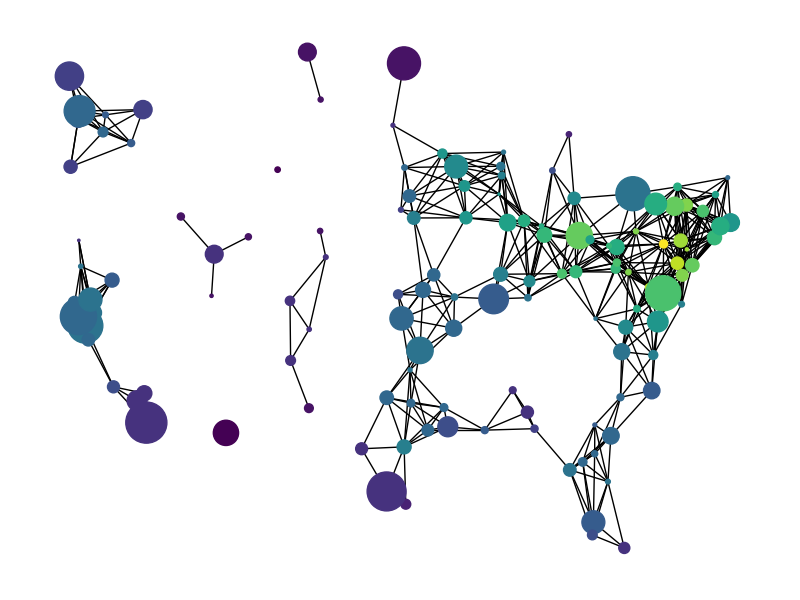Note
Go to the end to download the full example code.
Knuth Miles#
miles_graph() 返回一个包含128个美国城市的无向图。每个城市都有位置和人口数据。边上标注了两个城市之间的距离。
这个例子在以下章节中描述:
唐纳德·E·克努特 (Donald E. Knuth),《斯坦福图基:组合计算平台》(The Stanford GraphBase: A Platform for Combinatorial Computing),ACM出版社,纽约,1993年。 http://www-cs-faculty.stanford.edu/~knuth/sgb.html
数据文件可以在以下链接找到:

Loaded miles_dat.txt containing 128 cities.
Graph with 128 nodes and 8128 edges
import gzip
import re
# 忽略与使用cartopy下载shp文件相关的任何警告
import warnings
warnings.simplefilter("ignore")
import numpy as np
import matplotlib.pyplot as plt
import networkx as nx
def miles_graph():
"""返回Stanford GraphBase中的miles_dat.txt文件中的城市示例图。
"""
# 打开文件 miles_dat.txt.gz(或 miles_dat.txt)
fh = gzip.open("knuth_miles.txt.gz", "r")
G = nx.Graph()
G.position = {}
G.population = {}
cities = []
for line in fh.readlines():
line = line.decode()
if line.startswith("*"): # 跳过注释
continue
numfind = re.compile(r"^\d+")
if numfind.match(line): # 这一行是距离
dist = line.split()
for d in dist:
G.add_edge(city, cities[i], weight=int(d))
i = i + 1
else: # 这条线表示一个城市,位置,人口
i = 1
(city, coordpop) = line.split("[")
cities.insert(0, city)
(coord, pop) = coordpop.split("]")
(y, x) = coord.split(",")
G.add_node(city)
# 分配位置 - 将字符串转换为经纬度
G.position[city] = (-float(x) / 100, float(y) / 100)
G.population[city] = float(pop) / 1000
return G
G = miles_graph()
print("Loaded miles_dat.txt containing 128 cities.")
print(G)
# 创建一个新的城市图,如果两个城市之间的距离小于300英里,则它们之间有边连接
H = nx.Graph()
for v in G:
H.add_node(v)
for u, v, d in G.edges(data=True):
if d["weight"] < 300:
H.add_edge(u, v)
# 使用matplotlib/pylab绘图
fig = plt.figure(figsize=(8, 6))
# 节点按度数着色,按人口大小调整尺寸
node_color = [float(H.degree(v)) for v in H]
# 使用cartopy为可视化提供背景
try:
import cartopy.crs as ccrs
import cartopy.io.shapereader as shpreader
ax = fig.add_axes([0, 0, 1, 1], projection=ccrs.LambertConformal(), frameon=False)
ax.set_extent([-125, -66.5, 20, 50], ccrs.Geodetic())
# 添加国家及美国各州的背景地图
for shapename in ("admin_1_states_provinces_lakes_shp", "admin_0_countries"):
shp = shpreader.natural_earth(
resolution="110m", category="cultural", name=shapename
)
ax.add_geometries(
shpreader.Reader(shp).geometries(),
ccrs.PlateCarree(),
facecolor="none",
edgecolor="k",
)
# 注意:当使用cartopy时,直接使用matplotlib而不是nx.draw
# 利用cartopy的变换功能
ax.scatter(
*np.array(list(G.position.values())).T,
s=[G.population[v] for v in H],
c=node_color,
transform=ccrs.PlateCarree(),
zorder=100, # 确保节点位于边线/状态线的上方
)
# 绘制城市之间的边
for edge in H.edges():
edge_coords = np.array([G.position[v] for v in edge])
ax.plot(
edge_coords[:, 0],
edge_coords[:, 1],
transform=ccrs.PlateCarree(),
linewidth=0.75,
color="k",
)
except ImportError:
# 如果cartopy不可用,绘图的背景将为空白;
# 尽管如此,你仍然应该能够辨别出美国的大致形状
# 从图节点和边中!
nx.draw(
H,
G.position,
node_size=[G.population[v] for v in H],
node_color=node_color,
with_labels=False,
)
plt.show()
Total running time of the script: (0 minutes 0.046 seconds)